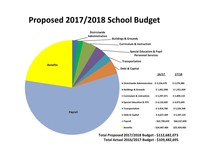School budget increased by $3.2M
Robotics team is promised $20,000
The Rockville Centre Board of Education introduced its 2017-18 school budget at its meeting on Feb. 15. The spending plan, totaling just under $112.7 million, is $3.2 million larger than the current budget.
The plan reflects increases in the tax levy, state aid, non-resident tuition and other revenue, such as summer school, as well as a $400,000 transfer from the employees retirement system reserve. State aid will be almost $1.7 million, an increase of about 16 percent.
“Virtually all of it is due to the building aid that we’re getting, and that’s from … bond expenses,” said Rob Bartels, assistant superintendent. District projects are approved by the state, and the state reimburses a percentage of the funds for those projects.
Due to the building aid increase, the tax levy limit is tentativey set at .746 percent, but will not exceed .75 percent, according to superintendent Dr. William Johnson. He added that a final tax levy number will be determined in March.
South Side High School underwent a major facelift over the course of 3½ years, which was funded by $30 million of a $45 million bond that residents approved in March 2013. The bond also financed an expansion of Watson Elementary School as well as upgrades and renovations around the district, including the installation of air conditioning in every classroom. That work was completed last summer.
The proposed tax levy, the total amount the district will collect from village residents and businesses, is $92.5 million, $685,000 more than this year’s budget. The state tax cap figure is due on March 1, but Bartels said that the tax levy will fall below the cap. Expenses and revenues are balanced at roughly $113 million.
Payroll accounted for over half of the budget, at almost $65 million, a $1.7 million increase. There will be no staffing cuts, and the district will add one teacher, two teacher assistants, two teacher aids, a security guard, a cleaner and a groundskeeper, at a combined cost of $350,000.
The cost of employee benefits also rose slightly, to just over $25 million, the district’s second-highest expenditure. Teacher retirement costs have been budgeted at $5.4 million, $2 million less than this year. Retirement payments have decreased in each of the past three years, after peaking at just over $8.4 million in 2014-15.
One surprise addition to the budget was a relatively small item, $20,000 earmarked for the high school and middle school robotics programs. In recent months, several student robotics enthusiasts have addressed the school board, expressing concern over the lack of funding for the program at the high school. Johnson said at the Jan. 18 meeting that Board of Education trustees would examine the budget and try to find money to support the program.
“Thank you for hearing us, and thank you for supporting our young people,” said Christine Bingham, whose daughter Anna is on the middle school robotics team. “They’re excited to go forward to high school next year with so much more support.”
Following the budget presentation, Johnson cautioned the attendees about the figures. “It looks like we’re swimming in money right now, [but] we’re not,” he said. “It’s because of the addition of expenses that we accrued as a result of the projects that we have under way. It is very, very important for us to understand that we really need to focus on and increase the amount of aid that comes to us.”
There were some lighter moments during last week’s meeting. When the school board invited audience members’ inquiries, four of the five people who asked questions were Cub Scouts — Nicky and James Giangregorio, Nick VanGelder and Kyle Schultz, members of local Troop 214, who were fulfilling part of their requirements for the Citizenship in the Community Merit Badge. The youngsters, sometimes reading from prepared notes, asked about the finances of the robotics club last year, whether there were any budgetary reductions that officials had not highlighted, what the definition of a tax levy was, why teachers need to get paid when they retire, and how much money is allocated to each school subject, much to the delight of the small crowd. District officials patiently answered each question.









